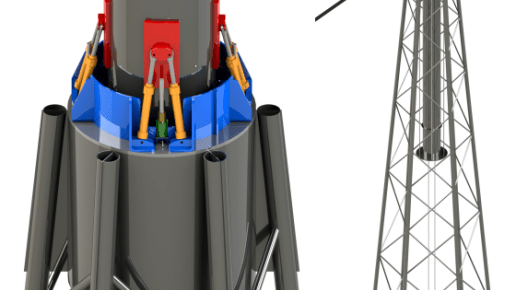Project description
The aim of the research project is to develop a self-erecting tubular steel lattice mast hybrid tower for wind turbines in order to increase the hub height and thus the electricity yield while simultaneously reducing the erection costs. While the lattice mast is erected conventionally up to 120 m, the tubular steel tower is erected in parallel inside and is then moved into its final position using a strand lifting system including the nacelle. Hydraulic cylinders ensure the absorption of horizontal forces, bending and torsional moments in the transition area. The results of the project are incorporated into a guideline for practical dimensioning and implementation.
Focus of the project
The project aims to develop an innovative, self-erecting tubular steel lattice mast hybrid tower for wind turbines. The focus is on
-
Increasing the hub height to increase the electricity yield.
-
Reduction of erection costs through a new type of strand lifting system.
-
Practical construction design tools to simplify planning and execution.
-
Development of a guideline for practical implementation.
Everything at a glance
Research methods & procedure
Concept development for the erection of a wind turbine
- Tower construction, basics of modeling
- System parameters, boundary conditions, locations
- Investigation and design of the lifting process
- Investigation of the design types of the lattice tower
- Transition piece, design and pre-dimensioning
Load modeling of the wind turbines from turbine operation and tower pre-design
- Development of the automated interface to FAST and TURBSIM
- Load modeling in the operating state for pre-design of the tower
- Predesign of the hybrid tower and documentation
Load modeling of the WTG in the construction state
- Definition of the interfaces to the transition piece and lifting technology
- Definition of the load scenarios and control strategies to be investigated
- Load modeling in the construction stage
- Incorporation of the critical points of the construction stage into the tower design
Wind tunnel tests
- Creation of wind tunnel models
- Measurements on section models
- Wind tunnel measurements on a scaled system model
Detailed investigations of the components required for the lifting technology
- Creation and calibration of FE model "tower cylinder"
- FE investigations "patch loading"
- Definition of the cylinder requirements
Design of the hydraulic stabilization system
- Design/arrangement of the linear drives
- Definition of the hydraulic control architecture incl. control concept
- Creating a safety concept
Adaptation of the transition piece
- Creation of FE model "transition piece"
- Dimensioning of the transition piece
Simulation of the lifting process
- Illustration of the hydraulic system
- Mapping the interaction between tower and stabilization system
- Mapping of wind loads
- Simulation of lifting processes
Design, dimensioning, layout and optimization of the structure
- Development of the automated interface between design tools
- Adaptation of the programming environment for the hybrid tower
- Development of load generation
- Holistic wind turbine design (hybrid tower, transition piece, lifting system)
Economic valuation
- Construction costs
- Specific cost values
- Comparison with other methods
Funding bodies and cooperation partners
Funding: Federal Ministry of Economics and Climate Protection (BMWK), Industrial Collective Research iGF
Research association: FOSTA - Research Association for Steel Application
RWTH Aachen University, Center for Wind and Earthquake Engineering (CWE)
RWTH Aachen University, Institute for Fluid Power Drives and Systems (IFAS)



